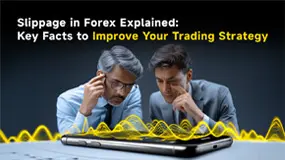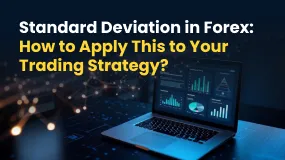简体中文
繁體中文
English
Pусский
日本語
ภาษาไทย
Tiếng Việt
Bahasa Indonesia
Español
हिन्दी
Filippiiniläinen
Français
Deutsch
Português
Türkçe
한국어
العربية
Trading without a trading plan: a plan for disaster
Abstract:I do not care how amazing your trading strategy is. Without a trading plan, you are going to war without a bulletproof vest. Yes, you may get a few lucky shots in, but all that will stop you is that one stray bullet that will mess up your flow. The same goes with trading, if you enter the charts without a plan, then all it will take is that one unlucky trade that will mess up your profits. You need a plan, and today we will discuss why a trading plan is so important and how to make one.

I do not care how amazing your trading strategy is. Without a trading plan, you are going to war without a bulletproof vest. Yes, you may get a few lucky shots in, but all that will stop you is that one stray bullet that will mess up your flow. The same goes with trading, if you enter the charts without a plan, then all it will take is that one unlucky trade that will mess up your profits. You need a plan, and today we will discuss why a trading plan is so important and how to make one.
Why do you need a trading plan
The short answer is that in a limitless murky world like the trading environment where you can open and close trades all your like, you need a sure guide that will lead to profits and LIMIT YOUR LOSSES. I place an emphasis is limiting losses because that will be the biggest factor that will determine your success. What causes losses then? :
1) opening positions that are leveraged too high
2) placing trades without a calculated stop loss
3) over trading
The trading place prevents all of that by placing rules that take away the thinking process in the middle of your trades and have you operate like a robot in your best interests. With a trading plan, you set limits on how much you will lose or win in a day so you already know the maximum that you will lose prematurely you can already set your losses low and be prepared for a negative out come.
You will also place a daily profit target with the plan that will limit the number of trades you open in a day. One of the reasons people do not make a profit is because they do not know when to leave the market. Even when they have made profits they insist on trading to get more and bam you lose your profits and you start revenge trading and losing profits on bad trades you take just to recover what you already have. With a profit target, you leave the charts with your profits and cash out. You take from the market whilst the taking is good.
How do create a trading plan
You need a ask yourself a bunch of questions and write down the answers as a set of rules. The questions are
1) What are the rules of my trading strategy
2) what time of the day do I prefer to trade
3) what much am I prepared to lose in a single trade
4) how much am I prepared to lose in a single day/week
5) how much can I make in a day that I consider to be enough for my risk appetite
The answers to these five questions will aid you to create the basis of your trading plan. As you write it down if you want to think of other additional rules that may be specific to your trading strategy and risk appetite. You may place a rule like “ I will open a trade only when I see a morning star candle stick pattern” or “once I make $100 today I stop opening new trades l, secure profits, and manage the trades that are already opened”. The basic idea here is to keep a general guide that will keep you honest and repeat the excellent habits that keep you far away from the reds and deep in the blues.

Disclaimer:
The views in this article only represent the author's personal views, and do not constitute investment advice on this platform. This platform does not guarantee the accuracy, completeness and timeliness of the information in the article, and will not be liable for any loss caused by the use of or reliance on the information in the article.
Read more

A Guide to Determining the Optimum Forex Leverage
Want to gain a wider forex market position control by investing a minimal amount? Consider using leverage in forex. It implies using borrowed funds to raise your trading position more than your cash balance can let you do it. Forex traders usually employ leverage to churn out profits from relatively small currency pair price changes. However, there is a double-edged sword with leverage since it can multiply profits as well as losses. Therefore, using leverage in the right amount is key for traders. Forex market leverage can be 50:1 to 100:1 or more, which remains significantly greater than the 2: leverage usually offered in equities and 15:1 leverage in futures.

Slippage in Forex Explained: Key Facts to Improve Your Trading Strategy
Have you witnessed a difference between the expected price of a trade and the price at which it is executed in real time? This might be due to slippage, which can happen at any time. However, it prevails mostly when the market remains highly volatile. At the same time, it can also happen during large order executions. Read on to know more about slippage, its impacts, and the strategies to rein in adverse effects.

Forex Trading Account Types and Their Features: Read This Insightful Guide
Want to open a forex account to enjoy the thrill of compounding returns? You should first know the various forex trading account types. Choosing the right option from the list of forex accounts is critical to experiencing a hassle-free and successful trading journey. Forex brokers design trading accounts based on your needs, trading experience, and financial goals. Therefore, understanding each forex trading account type and its key features becomes essential.. This will help you make the right choice. In this article, we have discussed everything about forex accounts. Take a look!

Standard Deviation in Forex: How to Apply This to Your Trading Strategy?
Do you recall the concept of standard deviation being taught in your school days? The concept, which measures the variation within a set of data points relative to the mean average of the dataset. A greater standard deviation hints at higher variability. On the other hand, a lower standard deviation means lower variability from the mean. But what is standard deviation in forex, and how can you apply it to your trading strategy? This is what we will discuss here.
WikiFX Broker
Latest News
The Debt-Reduction Playbook: Can Today's Governments Learn From The Past?
FIBO Group Ltd Review 2025: Find out whether FIBO Group Is Legit or Scam?
Is INGOT Brokers Safe or Scam? Critical 2025 Safety Review & Red Flags
The Hidden Reason Malaysian Traders Lose Money And How Timing Can Fix It
InterTrader Exposed: Traders Report Unfair Account Blocks, Profit Removal & Additional Fee for Withd
Germany's "Council Of Economic Experts" Calls For Higher Inheritance Taxes, And Bows To The State
INGOT Brokers Withdrawal Problems: 2025 User Alert - What You Need to Know
Upforex Withdrawal Problems: Understanding Delays and Risks
Currency Calculator




